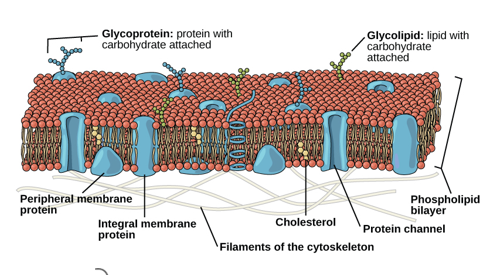7.1 The Plasma Membrane Components and Structure
0.0(0)
0.0(0)
Card Sorting
1/8
Earn XP
Description and Tags
Study Analytics
Name | Mastery | Learn | Test | Matching | Spaced |
|---|
No study sessions yet.
9 Terms
1
New cards
In 1935, Davson and Danielli proposed a "railroad track" model of the plasma membrane with proteins as "==blank==" and lipids as "==blank==."
In 1935, Davson and Danielli proposed a "railroad track" model of the plasma membrane with proteins as "==bread==" and lipids as "==filling==."
2
New cards
What is the Fluid Mosaic Model?
A model of the structure of the plasma membrane as a mosaic of components, including phospholipids, cholesterol, proteins, and glycolipids, resulting in a fluid rather than static character.
3
New cards
In a typical human cell, proteins make up about 50% ==blank==, 40% ==blank==, and 10% ==blank== of the plasma membrane's composition.
In a typical human cell, proteins make up about 50% ==lipids==, 40% ==proteins==, and 10% ==carbohydrates== of the plasma membrane's composition.
4
New cards
==Blank== proteins are embedded in the membrane, while ==blank== proteins are on its surfaces. They have roles in transport, enzymatic activity, and cell recognition.
==Integral== proteins are embedded in the membrane, while ==peripheral== proteins are on its surfaces. They have roles in transport, enzymatic activity, and cell recognition.
5
New cards
Carbohydrates on the cell's exterior form the ==blank==, attracting water and aiding in cell recognition and immune response differentiation.
Carbohydrates on the cell's exterior form the ==glycocalyx==, attracting water and aiding in cell recognition and immune response differentiation.
6
New cards
==blank== helps maintain membrane fluidity and buffers against temperature changes.
==Cholesterol== helps maintain membrane fluidity and buffers against temperature changes.
7
New cards
Cells specialized in absorption, like those in the small intestine, have ==blank==—finger-like projections that increase the plasma membrane's surface area.
Cells specialized in absorption, like those in the small intestine, have ==microvilli==—finger-like projections that increase the plasma membrane's surface area.
8
New cards
Celiac disease causes an immune response to gluten, damaging ==blank== and leading to nutrient absorption issues, malnutrition, cramping, and diarrhea. A gluten-free diet is necessary for patients with celiac disease.
Celiac disease causes an immune response to gluten, damaging ==microvilli== and leading to nutrient absorption issues, malnutrition, cramping, and diarrhea. A gluten-free diet is necessary for patients with celiac disease.
9
New cards
Visualize the Plasma Membrane
